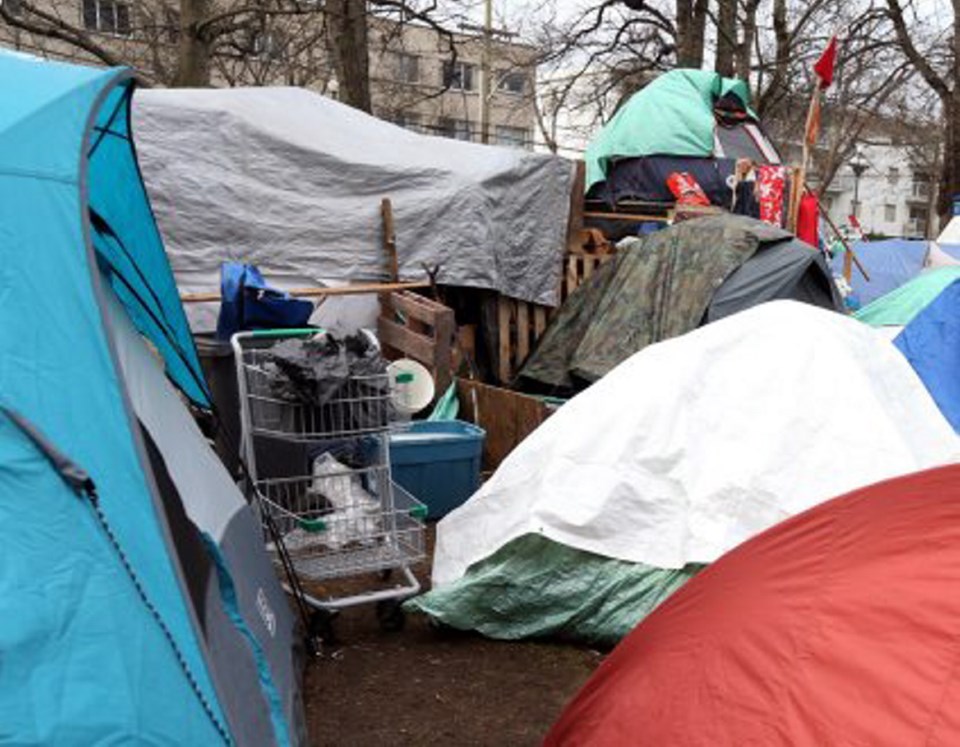 Housing Minister Rich Coleman has no plans to be “provocative or ham-fisted” if there are still campers at the courthouse tent city after Thursday, the deadline to vacate.
Housing Minister Rich Coleman has no plans to be “provocative or ham-fisted” if there are still campers at the courthouse tent city after Thursday, the deadline to vacate.
So there might still be a number of campers there after time elapses on the period given for them to vacate the area.
The “block party” planned by inhabitants on that day, expected to attract supporters from out of town, adds to the uncertainty about the future of the camp.
It’s been three weeks since the government put together a three-point end-game plan to bring the occupation of the courthouse lawn to a close. The ministry closed a deal to buy the nearby Mount Edwards Court Care home on Vancouver Street for $3.65 million from the Baptist Housing Society. The building has room for 38 transitional housing units to be run by the Victoria Cool Aid Society for the next 12 months. The first former tenter moved in Tuesday morning and the Cool Aid Society expects a lot more uptake.
Cool Aid official Don McTavish said people are interested, anxious and relieved all at the same time about the prospect of moving in. He said it’s exciting to be able to offer housing help to people he’s known for some time.
The second point was a quick conversion of the all-but-empty Youth Custody Centre in View Royal. There is room for 50 shelter units and the option to have camping in an interior courtyard, which could accommodate 20 tents. It is expected to be open for six months.
The third point was the deadline, hand-delivered on Feb. 5 to the courthouse campers, giving them until Thursday to vacate.
With two new housing options and an offer of 40 more rent-supplement cheques for people to live elsewhere, the ministry considers there are enough options on the table to clear out the courthouse lawn.
The rally planned for Thursday afternoon will obviously include a political protest against all the conditions that led to the camp in the first place. It’s how many people who remain there on Friday that will determine whether the government’s approach is going to work.
Cleaving the campers into two groups — people who desperately need help and have no place to go, and people who are there as a political protest — is clearly part of the strategy.
Coleman said Tuesday the first group will have the help people need. “We have enough units for the people there, we’ve done a lot of work with the two societies, trying things that will be innovative. I don’t see any reason why they need to stay. We’ll watch as the population decides what it’s going to do. I know a number have already committed to leave.
“But we’re not going to just go out and provocatively do something. I’ve been looking at the process all the way along from the housing side, looking for long-term solutions.”
Coleman said any rally-goers who arrive from elsewhere are protesting on the backs of disenfranchised people suffering from mental health problems, addiction and other issues.
“I realize they want to protest but they’d protest whether we found a solution or not,” he said. “Connecting people with supports, that’s what they should be doing, rather than turn them into an issue.”
Whatever remaining issues there are after Thursday will be assessed day by day, he said. “We’re not going to be provocative or ham-fisted. I’m more concerned about the vulnerable people there than the activists who aren’t there for the right reasons.”
But various postings from people on site say all the moves are aimed at displacing people to temporary and limited locations.
“Tent cities and housing that is created and run by those who live there is the solution to the housing crisis in B.C.,” said one.
Another person said Thursday afternoon will be a peaceful protest joined by one busload of supporters from Metro Vancouver.
If there are still people living on the lawn on Friday, it’s likely the legal process will begin. Injunctions, enforcement orders and possible court citations are the usual route, all of which take time.



